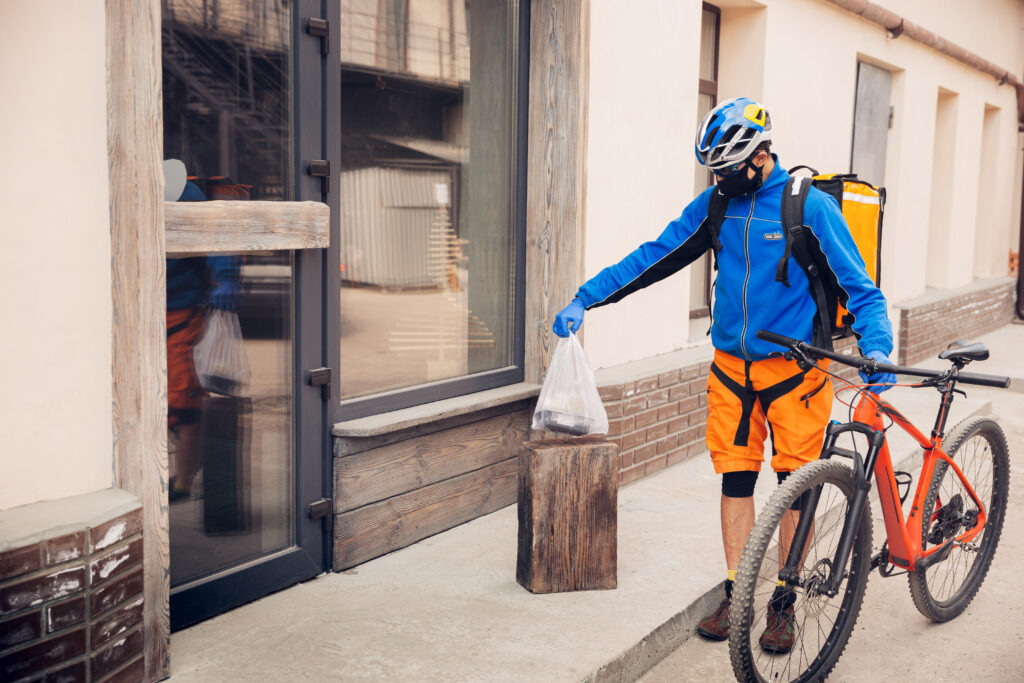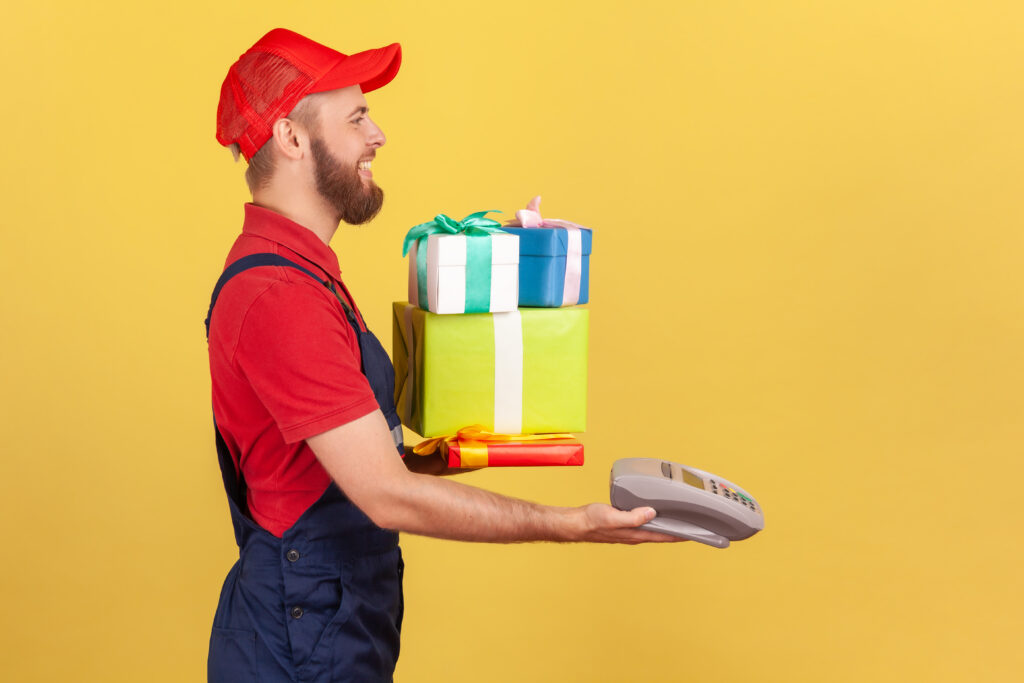In our modern world of instant gratification, it’s no wonder that contactless delivery is becoming more popular. But what is it, and why does it matter?
Contactless delivery is a way of receiving items without having to touch or handle them. Instead, they are delivered straight to your doorstep. This may seem like a small convenience, but it has the potential to make a big impact on our daily lives.
This new way of delivering packages promises to save customers time and hassle, but what is behind this new wave of contactless delivery, and why does it matter? In this post, we take a closer look at contactless delivery and its potential impacts on both businesses and consumers.
What is Contactless Delivery?
Contactless delivery is the practice of delivering goods and services without physical contact between the recipient and the delivery person. This can be achieved through various means such as curbside pick-up, drop-off boxes, or by using contactless payment methods.
The goal of contactless delivery is to minimize the risk of transmission of communicable diseases, such as the flu, cold, or COVID-19.
With contactless delivery, customers can simply place their orders and have them delivered to their doorstep without having to worry about coming in contact with the delivery person.
This not only offers a more convenient way to receive packages, but it also helps to protect both the customer and the delivery person from the risk of infection.
Furthermore, contactless delivery is also becoming popular among businesses as it helps to protect their employees from the risk of infection. With this type of delivery, businesses can still offer their customers the convenience of having their orders delivered without putting their employees at risk.
In addition, contactless delivery can also help to reduce the amount of time that employees spend on deliveries, which can help to improve their productivity.
How Does Contactless Delivery Work?
Contactless delivery technology is a type of delivery service that allows customers to receive their orders without having to physically interact with the delivery person. This type of service is becoming increasingly popular as it offers a more convenient and safe way to receive packages, especially during the COVID-19 pandemic.
So how does a contactless software delivery work?
When you place an order with a contactless delivery option, the delivery person will bring your package to your door but will not knock or ring the doorbell. Instead, they will leave the package at your doorstep and send you a notification that it has been delivered. You can then retrieve the package at your convenience.
Most contactless delivery services are available 24 hours a day, so you can receive your package whenever it is convenient for you. This type of delivery is especially useful if you are not home during the day or if you do not want to interact with the delivery person.
If you are interested in using a contactless delivery service, be sure to check with your local store or online retailer to see if they offer this option. Contactless delivery is a convenient and safe way to receive your orders, especially during these uncertain times.
Benefits From No Contact Delivery
No contact delivery comes with a few benefits that can be extremely helpful. Such benefits are the following.
Safety
One of the main benefits of no contact delivery is the safety that it provides. This type of delivery eliminates the need for customers and employees to interact with one another, which reduces the risk of transmission of communicable diseases.
In addition, no contact delivery can help to protect vulnerable populations, such as the elderly or those with underlying health conditions, from exposure to communicable diseases.
Convenience
Another benefit of no contact delivery is the convenience that it provides. This type of delivery eliminates the need for customers to leave their homes or workplaces in order to receive their goods or services.
This can be especially beneficial for those who have busy schedules or who live in remote areas.
Efficiency
Another benefit of no contact delivery is that it can be more efficient than traditional methods. This is because no contact delivery eliminates the need for customers and employees to interact with one another, which can save time.
In addition, no contact delivery can help to reduce the number of people in a given area, which can help to reduce congestion and make it easier for people to social distance.
Competitive
No contact delivery can also provide a competitive advantage for businesses. With the growing demand for contactless services, offering no contact delivery can attract more customers and retain existing ones.
Customers are increasingly valuing safety and convenience, and businesses that can meet these demands through no contact delivery are likely to stand out in the market.

Which Industries Benefit From Using Contactless Delivery?
There are a few different industries that can benefit from using contactless delivery. This includes the following:
3PL Providers
Third-party logistics (3PL) providers can benefit from using contactless delivery. This is because 3PL providers typically manage the distribution of goods for a variety of different businesses.
By using contactless delivery, 3PL providers can help to minimize the risk of transmission of communicable diseases, as well as improve the efficiency of their operation.
Food Delivery and Restaurants
The food and beverage industry can also benefit from using contactless delivery. This is because the industry is highly regulated, and there is a need to minimize the risk of foodborne illnesses.
In addition, by using contactless delivery, businesses in the food and beverage industry can help to improve their efficiency and reduce the amount of time that customers have to wait for their food.
eCommerce Retailers
eCommerce retailers can also benefit from using contactless delivery. This is because eCommerce retailers typically ship a large number of orders on a daily basis.
When using contactless delivery, eCommerce retailers can help to improve their efficiency, as well as reduce the risk of damage to their products. In addition, by using contactless delivery, eCommerce retailers can help to ensure that their customers receive their orders in a timely manner.
Pharmaceutical and Medical Companies
Pharmaceutical and medical companies can also benefit from using contactless delivery. This is because these companies typically ship a large number of orders that contain sensitive items, such as prescription medications.
The use of contactless delivery can help to ensure that these items are delivered in a safe and timely manner. In addition, by using contactless delivery, pharmaceutical and medical companies can help to reduce the risk of theft or to tamper with their products.
How to Implement Contactless Delivery
To offer contactless delivery is a great way to adapt your business to the changing landscape and customer expectations, especially in times of health concerns. Here’s a step-by-step guide to help you implement contactless delivery:
- Analyze and understand your current delivery model – Assess your current delivery process to identify potential points of contact between your staff and customers. Understand how orders are processed, packed, and delivered to the customers’ doorstep.
- Develop a clear contactless delivery protocol – Create a detailed plan that outlines the steps to be followed for contactless delivery. This protocol should cover the entire delivery process from order placement to delivery and should ensure minimal to no physical contact.
- Invest in the right technology – To facilitate contactless delivery, invest in the necessary technology and tools. This might include online ordering platforms, mobile apps, GPS tracking systems, or contactless payment options.
- Train your staff – Educate your staff about the contactless delivery protocol and the importance of maintaining hygiene and social distancing during the delivery process. Train them on using new technologies and following safety guidelines.
- Communication with your customers – Inform your customers about the contactless delivery option and the safety measures you’re taking. Update your website and social media channels to reflect the changes in your delivery model.
- Provide flexible delivery options – Offer multiple delivery options to accommodate different customer preferences. This might include curbside pickup, no-contact doorstep delivery, or the use of delivery lockers.
- Implement a secure payment system – Enable secure online payment options to minimize physical contact during the payment process. Offer contactless payment methods such as credit/debit cards, mobile wallets, or online payment gateways.
- Establish a contactless proof of delivery system – Develop a process for confirming delivery without direct contact. This could involve taking a photo of the delivered package at the customer’s doorstep, sending delivery confirmation emails or messages, or using delivery tracking systems.
Key features of contactless delivery software
Real-time tracking
Real-time tracking is a crucial feature of contactless delivery software that provides customers with up-to-the-minute information about the status and location of their delivery.
When a customer places an order, they receive a unique tracking link or code, which they can use to monitor their package’s journey. This feature enhances transparency and builds trust with customers as they can stay informed about their delivery’s progress and estimated arrival time.
Real-time tracking also helps delivery personnel optimize their routes and manage their schedules more efficiently, leading to faster and more accurate deliveries.
Contactless proof of delivery
Contactless proof of delivery is another key feature of contactless delivery software. With this functionality, delivery drivers can capture proof that the package was delivered to the right recipient without requiring any physical interaction.
This is usually done through various methods such as capturing a photo of the delivered package at the recipient’s doorstep, obtaining an electronic signature, or using QR code scans. The proof of delivery data is then stored securely and can be accessed by both the delivery company and the customer if needed.
This feature adds an extra layer of security and eliminates the need for physical paperwork or signatures.
Image capturing
Image capturing is a component of contactless proof of delivery, but it also serves other purposes. Delivery personnel can take pictures of packages before they are sent out for delivery to document their condition and ensure that the correct items are being dispatched.
Additionally, image capturing can be utilized to record any damages or issues with the package during delivery process, making it easier to handle any claims or disputes that may arise.
Customer communication
Customer communication is a critical aspect of contactless delivery software. The software should enable seamless communication between the delivery company, the delivery personnel, and the customer.
Automated updates and notifications keep the customer informed about the status of their delivery, from the moment the order is placed until it is delivered. Customers may receive real-time updates via SMS, email, or in-app notifications, allowing them to stay informed and plan accordingly.
This two-way communication also allows customers to provide delivery instructions, reschedule deliveries, or address any concerns they may have, further enhancing the overall delivery process.
Contactless Delivery with Detrack!
Contactless delivery is a great way to ensure that your packages are delivered safely and on time. When choosing contactless delivery software, it is important to consider your specific needs and compare features and prices before making your final decision.
Try to take advantage of free trials whenever possible, and don’t hesitate to reach out to an expert for help if you need it. With the right software in place, you can rest assured that your packages will be delivered safely and on time.
If you are looking for contactless delivery technology, Detrack is a great option to consider. Create an account and try it today!
Frequently Asked Questions about Contactless Delivery
What technology do we need for contactless delivery?
To implement contactless delivery options, you’ll need various technologies, including a robust delivery management software or platform that supports real-time tracking, digital communication with customers, and proof of delivery capabilities. You may also require GPS-enabled devices for drivers to facilitate tracking, and mobile apps for customers to receive notifications and provide delivery instructions. Additionally, contactless payment options, such as online payment gateways, are essential to complete the contactless delivery experience.
How can we train our drivers for contactless delivery?
Training drivers for contactless delivery work involves educating them about the new delivery process and ensuring they are proficient in using the required technology. Training should cover aspects like handling contactless proof of delivery methods, using the delivery management software, and adhering to safety protocols during the delivery process. Role-playing scenarios can be helpful in preparing drivers for various situations they might encounter during contactless deliveries.
How does contactless delivery affect delivery times?
Contactless delivery can have a positive impact on delivery times. By reducing the need for physical interaction and paperwork, the delivery process can become more streamlined and efficient. Real-time tracking and optimized delivery routes also contribute to faster deliveries. However, external factors like traffic, weather, and the volume of orders can still influence delivery times.
What if a customer isn’t home during a contactless delivery?
If a customer isn’t home during a contactless delivery, the driver can follow pre-determined delivery instructions provided by the customer, such as leaving the package at the doorstep or a designated safe location. Some delivery management systems allow customers to reschedule deliveries or provide specific time windows for delivery attempts. Alternatively, the driver can attempt to reach the customer through a contactless communication method, like sending a text message, to arrange an alternative delivery time.
How do we handle returns and exchanges with contactless delivery?
For contactless returns and exchanges, businesses can set up a process where customers can initiate return requests online or through the delivery management platform. The driver can then pick up the returned items from the customer’s doorstep without direct contact. Once the items are received back at the fulfillment center, the usual return or exchange procedures can be followed.
How can we handle cash on delivery in a contactless model?
Handling cash on delivery in a contactless model can be challenging, as it involves physical exchange and may not align with the contactless delivery concept. To overcome this, businesses can encourage customers to use contactless payment methods such as online payments, digital wallets, or credit/debit cards. Alternatively, you can explore cashless payment options like prepaid cards or electronic fund transfers before dispatching the order to avoid physical cash transactions during delivery.












